Maternal Health Care use among Rural Women of Asgede Tsi’mbla District of North Western Tigray, Ethiopia
Hadush Seare Desta*
Department of Anthropology, Institute of Paleo environment and Heritage Conservation, Mekelle University, Ethiopia
Submission: March 26, 2019; Published: April 17, 2019
*Corresponding author: Hadush Seare Desta, Department of Anthropology, Institute of Paleo environment and Heritage Conservation, Mekelle University, Mekelle, Tigray, Ethiopia
How to cite this article: Hadush Seare Desta. Maternal Health Care use among Rural Women of Asgede Tsi’mbla District of North Western Tigray, Ethiopia. Glob J Arch & Anthropol. 2019; 8(5): 555747. DOI: 10.19080/GJAA.2019.08.555747
Summary
The study revealed that the maternal health of women’s in rural of asgede tsimbla district These are malaria control and prevention, diarrhea control and prevention, immunization, family planning, ANC, referral for delivery, PNC, pit latrine construction, safe water use and health education initiated recently. The Low services utilization and health-seeking behavior is observed with the less availability of health education and awareness creation at household level similarly associated with the frequency of HEWs visits to households. HEWs emphasized in supervising specific helps like malaria control and prevention, diarrhea control and prevention and construction of pit latrine construction followed by assisting in the health post for the majority of the respondents for malaria treatment, immunization and family planning. The health post utilization of respondents and the visit of households by health extension workers are low. The availability of curative drugs, decision making, attitude of peoples toward the skill of HEWs and travel time to health institutions influences the health post utilization of peoples. HEWs have an important role in providing care in the health post and supervising households on health services; these are malaria control and prevention, pit latrine construction, promoting safe water use, child immunization, family planning, ANC, PNC, referral for delivery, diarrhea treatment and control and health education and communication study area.
There are challenges to the health extension workers in providing quality of service. Distance of health post and the scattered settlement of the community, lack of curative drugs in the health post, lack of skill competency, and the lack of time for visit households or a lot of works in the health post, difficult to reach areas (hilly areas), the strong cultural beliefs of the community and the lack of refresher course for HEWs are the major challenges which are reported by HEWs in the study area. Majority of the respondents who participated in this study have a positive attitude towards HEWs service provisions, communication skills, and social behaviors. The communication skill, quality of services provided and the social behavioral/conduct of HEWs influences the attitude of the community on health extension workers positively and negatively.
Abstract
Improving access to maternal and child health services was among the major objectives of the HEP (Health Extension Program) in Ethiopia. Few studies showed a comprehensive analysis of maternal health care. Further, understanding in detail factors affecting maternal health care use is crucial. Therefore, this study was conducted with the aim of assessing maternal health care utilization, the factors associated with maternal health care use and the attitude of women on social behavior of health workers in Asgede Tsimbla district, Tigray regional state. Thus, the researcher has randomly selected 263 women participants for quantitative data and other purposively selected for qualitative data in order to achieve the intended objectives of the study. The researcher used both quantitative and qualitative approaches. The result of the study identified maternal health care use in the health post to seek malaria treatment, child immunization and Antenatal Care followed by Postnatal Care, family planning, referral for delivery, diarrhea treatment and health education. The factors associated to maternal health are cultural beliefs, remoteness, and poor relation with providers, lack of curative drugs in health post, communication system and road construction. Attitude of women towards Health Extension Workers social behaviors is over all positive but to increase women’s health post utilization, health posts should be equipped with minimum essential medical equipment with a particular focus on malaria treatments, family planning, delivery, treatment of common illnesses and immunization services in the study area.
Keywords: Maternal health; Cultural beliefs; Health extension program; Health post
Introduction
Many countries have focused on increasing production and distribution of personnel in response to inadequate numbers of health personnel. This occurred in the 1980s particularly in the community health worker cadre although in the 1990s many such programmers faltered. The Health Extension Program (HEP) is a new program designed with a defined package of essential promotive, preventive and basic curative services targeting households, particularly mothers and children in a community. In Ethiopian context, through the health extension program, an intensive effort has been made to avail the service at the door steps of every person [1]. However, in most instances it is not used to the fullest due to several reasons. The mix of available service, poor linkage between the service points, transportation, and sense of seriousness among health professionals compromises the health care.
Improving access to maternal and child health services was among the major objectives of the HEP (Health Extension Program) in Ethiopia. So far, few studies showed a comprehensive analysis of maternal health care throughout the course of pregnancy; delivery and postnatal period the study assess the institutional delivery service utilization in Woldia [2], Also studied the factors affecting utilization of skilled maternal care in Northwest Ethiopia [2], and the MSc. thesis conducted on the determinants of antenatal and delivery care utilization in Jijiga Town [3], Somali regional state. But, further understanding in detail factors affecting maternal health care use is crucial. Therefore, this study was conducted with the aim of assessing maternal health care utilization, the factors associated with maternal health care use and the attitude of women on social behavior of health workers in Asgede Tsimbla district, Tigray regional state. Primary data were collected from the sampled population/targeted population through survey and in-depth interview, focused group discussion, case study, key informant interview with community elders, local administrative, HEWs and HDAs. However, the Secondary source of data in this study is published and unpublished books, journals, articles, websites, and official documents such as surveys, policy statements, and professional guidelines.
Sampling Method
Lmat T’abya is selected randomly from the 27 kebelles of Asgede Tsimbla district. While conducting this study Qualitative and Quantitative approaches are used and the selected participants are selected by simple random sampling for household survey proportionally and then using the purposive sampling method data are collected from selected Qushets of selected participants through Interview, Case study, In-depth interview, Key informant interview, Focus Group Discussions, and Observations. Finally, to identify women to be included in the survey, simple random sampling technique was applied. When more than one eligible respondent is present in selected household one respondent is selected at spot by a lottery method.
Research Design
In this study in order to achieve the objectives, a mixed approach is used. In order to collect the quantitative data, the simple random sampling method for household survey is used and the purposive sampling method used for in-depth Interview, Case Study, Focused Group Discussion and Key Informant interviews to collect the qualitative data. For Sample size selection the formula [4] (n=N/(1+N(e)2) is used for randomly selected 263 households survey and purposively selected 15 households for an in-depth interview, 5 for key informant interview, 4 for a focus group discussion and 5 for case studies. Descriptive data analysis is used for analyzing the already collected data’s, and the quantitative data is analyzed using simple statistics.
Sample Size
The quantitative survey was conducted on married women who gave birth in the last 12 months prior to data collection. Samples of the study are taken from 770 households of the study area using the formula for household survey. n=N/ (1+N (e)2 While n=sample size (study population) N=source population 1= the probability of the event occurring. e= maximum variability or margin of error 5%. So, n=N/ (1+N (e)) n= 770/ (1+770(0.05)) = 262.79263. Therefore, the required sample size for the present study is 263 respondents. Depending on this sample size for qualitative data’s purposive sampling method was used. From the total sample size of 263 households purposively 15 respondents are selected for in-depth interview, 5 households are selected purposively for key informants, four group discussion is also conducted in this study in each group 8 participant are participated and using the purposive sampling method 5 case studies are conducted.
Research Methodology
Research Approach
In order to attain the intended objectives of the study, the researcher used both quantitative and qualitative approaches.
Source of Data
The study used both primary and secondary sources of data to find pertinent information concerning the topic.
Data Collection Techniques
Household Survey
The questionnaires are developed first in the English language then it translated into local language, Tigrigna, to collect the quantitative data from the total sample size (263) of the study. The questionnaires are pretested for the clarity of questions on non-sampled households.
In-depth Interview
The primary data are collected through qualitative and quantitative data gathering technique and status of the informant’s face to face interview by using pre-prepared questionnaire. The questioner is both open-ended and closed ended questions to collect data from the respondents by using the interview. To get deep-rooted information the researcher is used an in-depth interview on the issue of health extension workers in the study area. Generally, the researcher has used fifteen In-depth interviews which are purposively selected.
Key Informant Interview
In the context, the term “key informant” means concerned body who have a close relation to the primary health care and who have deep information and knowledge about health care. These individuals are from health facilities or other service organizations in the community, HEWs, health workers, religious leaders, and community leader. The same questions are asked during all the interviews, but the interviewer is free to ask follow-up questions in order to get as much information as possible from the informant. The researcher has used five key informants (three community elders, two religious’ leaders) purposively selected from the sampled respondents.
Focus Group Discussions
A Focus Group Discussion (FGD) is an organized discussion on a single topic in a specified duration. It helps in the collection of qualitative (feelings or perceptions of the target audience) information. The focus group discussion technique is helpful to triangulate the data that are collected using other methods. As a result, the participants get the chance to discuss factors associated with maternal health. Furthermore, four focus group discussions were conducted, with two groups with women participants and two-group discussion with men participants. In each group discussion, eight participants participated (Table 1).
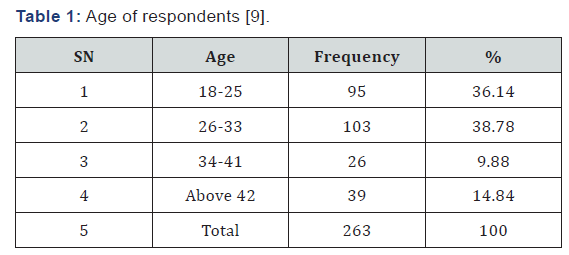
This study is done in Asgede Tsi’mbla district of northwestern Tigray regional state. In this study, a total sample size of 263 households participates. The response rate in the study was 100% with complete data obtained from 263 households. The 103(38.78 %) of the respondents are the largest proportion in the age group of 18-25 years old, while the least 26(9.88) % of the respondents represented age groups are observed 34-41 years old.
Case Study
A case study is a detailed description of one person’s or one group’s experience with an issue. It helps to put pieces of information into their proper perspective and they make a greater emotional impact than do statistical data. The researcher used four (two women elders, two men from community elders) case studies purposively selected about the issue of maternal health in the study area.
Observation
Using a nonparticipant observation technique, the researcher observes a specific location while trying not to attract much attention. The researcher has recorded as many observations as possible in a field diary. Therefore, the researcher has observed something the activities of HEWs in health post and out of the health post as well as the health post visit of the community (Table 2).
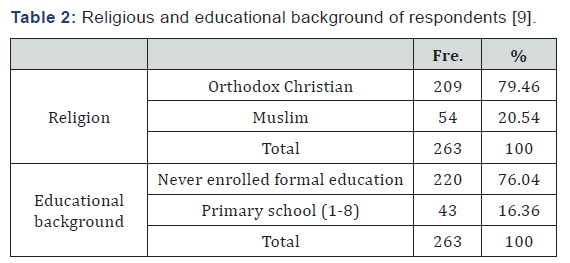
Shows, majorities 209 (79.46 %) of the participants of the study areas’ religion is orthodox Christian and the remaining participants 54(20.54%) were Muslims. The majority of the respondents had never enrolled in informal education 220(76.04%) and 43 (16.36% of the respondents had attended only primary school (grade 1-8).
Strategies of Data Analysis
The information collected from both primary and secondary sources is analyzed through a descriptive way. The researcher has first transcribed qualitative data from local language to English and translated into meaningful concepts and pattern. At the same time, quantitative data are analyzed using descriptive statistics like tables, frequency, and percentage and pie chart representation.
Study Area
The present study is conducted in Asgede Tsi’mbla district, Lima’t T’abya. The T’abya is one of the 27 T’abya of Asgede Tsi’mbla district. In this study area, there is only one health post.
Geographical Location
Lima’t T’abya is found in Asgede Tsi’mbla district which is the northwestern part of Tigray regional states. Lim’at T’abya is located 43Km in the western part of Asgede Tsi’mbla district, ‘Inda-baguna town. Lima’t T’abya is located at distance of 64Km from shire and 371Km from Mekelle, the capital city of Tigray regional state. Lima’t T’abya is bounded by Rahwa and Adi-Mehemeday T’abya in the western part, Hibret T’abya in the northern part (Table 3), Debre-mariam in the southern part as well as Alogen T’abya in the eastern part. Lima’t T’abya administratively sub divided in to four (4) rural Qushets.
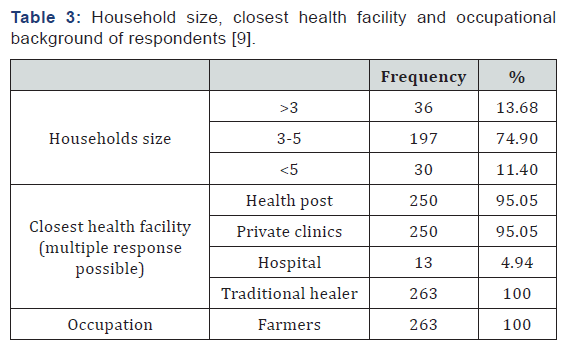
The household family sizes ranged from 3-5 are the most frequent family size which is 197(74.90%) and the remaining 30(11.40%) of respondents were less than three family size. The respondent’s mode of transport to health facilities was observed as all most all they are traveling on foot. The respondent’s closeness to health institutions was observed as the majority 263 (100%) was close to traditional healers followed by the health post and private health clinics 250 (95.05%) whereas the least remaining 13(4.96%) was close to health centers/ hospitals. Almost all 263(100%) of the study participants are farmers. The livelihoods of all respondents were dependent on agriculture such as crop production and animal raring and traditional gold mining.
Results and Analysis
This chapter includes the characteristics of respondents, major health service utilization of women, factors associated with maternal health care use and the attitude of women to HEWs social behavior.
Socio-Demographic Profile of Sampled Respondents
The following tables show the socio-demographic distribution of respondents. These include the sex, age, religion marital status, marriage types, educational level, languages, household size, occupation, health facility to households, and mode of transport and travel time and sources of income.
Maternal health care utilization
The HEP health packages service delivery by health extension workers began to implement in the health post after 2003 E.C. First two female health extension workers were deployed to deliver health packages to the community. But, later one female health extension added in order to assure the quality of service provision in health post. Moreover, the result of key-informant supports this finding as- “This health post is constructed after 1987 E.C. Initially there were two health professionals to give service for the community. At that time the occurrence of malaria diseases was very high. After 2003 E.C HEWs are deployed and began to deliver the health packages in health post [5].” The health post utilization of respondents in HEP of the study area within 12 months is identified by asking the type of health service they attended at least once a year or supervised by health extension worker.
The major services of health post utilization of respondents are to seek malaria treatment, child immunization and ANC followed by PNC, family planning, referral for delivery, diarrhea treatment and health education Source. The health post utilization of respondents to seek malaria treatment is high when it compared to other HEP service utilization of respondents, followed by child immunization, ANC, PNC, family planning, referral for delivery, diarrhea treatment and health education. This is due to the occurrence of malaria in the area and the affordable price for anti-malaria in the health post. The following in-depth interview of HEW, concern to Lim’at T’abiya supports this idea (Table 4). “The awareness of the community about malaria control and prevention is not that much developed. Malaria prevalence in this village is very high. Due to that reason, many people are sick malaria every day and they came to health post to seek treatment. Every month we measure the frequency of patients for every disease. The proportion of patients in the health post for malaria treatment exceed from all other HEP services which are delivered in the health post [6].”
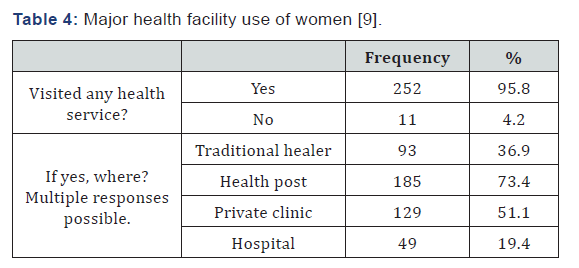
The above Table 4, shows, 11(4.2 %) didn’t visited any health posts within 12 months at least once, whereas the remaining 185(70.4%) respondents visit the health post within the past 12 months.
Factors associated with maternal health care use
There are different factors that force health post utilization. Respondents are replied that are preferring health post due to its proximity (nearness) and HP closeness to their homes and its affordability. Women’s are not interested to stay out of their homes. They have a lot of works (many responsibilities) at home like looking after children and preparing of foods. Due to that, they went to come back earlier to their homes. The following FGD clearly depicts the factor that attracts to health post utilization of women’s in the study area. “The reason why I am preferring to go to health post than other health institutions is that due to it is affordable and close to my home. Even though there are private clinics in our village and health center, which is three hours far with a good quality of service, they are not affordable to us. The closeness and affordability attract me to visit it than others [7]” (Table 5).
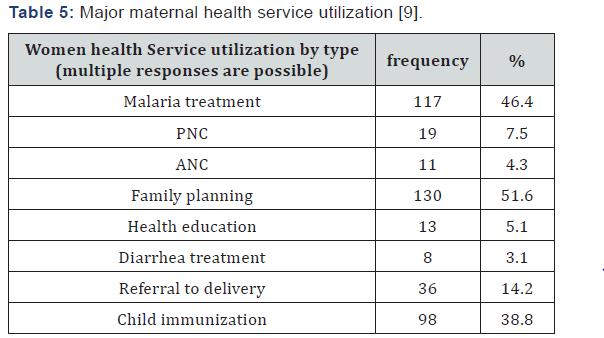
Also it shows that, 130 women’s of them visited health post for family planning, 98(38.8%) women’s for child immunization, 11(4.3%) women’s for ANC, 36(14.2%) women’s referral for delivery, 117( 46.4%) to seek malaria treatment, 19(7.5 %) women’s are for PNC, 13(5.1 %) for health education and 8( 3.1%) to seek Diarrhea treatment. This help to say there is high utilization of health post of by women to seek malaria treatment in the study area. Different reasons are mentioned to not utilizing health post by respondents. These are long distance traveling to health post and lacks curative drugs in health post. These factors affect the health post utilization of households. Due to this reason, women prefer to go to private clinics and traditional healers.
Regarding the decision making relating to maternal and child health, husbands decide at the household level in the study area. According to the respondent of the case study, this is because husbands have the power to decide in every household activity including the services that their family members should get. So, every decision made by the husband respected and followed. The health post utilization of women’s is influenced by the husband’s decision making. The following case study clearly shows the husband’s dominance in decision making in the household. “I visited health post when I was sick. In my family, the husband decides where to go if someone is sick. Most of the time my husband prefers the health post than other health institution due to its proximity. Last month my child was sick and went to the health post. However, I thought that there is no medicine in the health post from my experience and other neighbors. As a result, I want to go to the private clinic which is far from our village. But my husband did not agree with me to take the child to the private clinic because of the distance and its expensiveness [8]”.
The negative attitude of the community towards HEWs skill to diagnose diseases influences the preferences of the community regarding health service providers. Thus, most of the community members prefer to go to private clinics and health centers than the health post. In the FGD (Focus Group Discussion) with males, discussant indicates that the reasons for not using the health post services are the doubt of professional skill of the HEWs in diagnosing the diseases in the study area. One of the FGD, a participant reported the challenge relating to the skill of the HEW in the area as follow. “I visited the health post last year because I was sick malaria. HEWs test to my blood and told to me as I am not sick with malaria, but I know as I am sick because I sleep in my home for one week and did not feel healthy. Next time I forced to go to the health center. They told me as I am sick malaria and give me a drug with instructions. I take the drugs based on the directions given by doctors. Finally, am ok now. So, I understand that our HEWs in health post lacks the knowledge to identify diseases [9]” (Table 6).

Q.1 shows the Perception of households on the social behavior of HEWs are asked and 32(12.6%) are replied strongly agree as health extension workers are involving always during the happy and sad time of the community whiles the 127(48.29%) agree, undecided 38 (14.4%) Disagree 52 (19.7%) and 14(5.3%) strongly disagree. Table-6, Q.2shows on the attentiveness and caring of the HEW are also asked and replied that 50(19.1%) strongly agrees, 173(65.7%) agree, 4(1.5%) undecided 36(13.6%) disagree. Table-6, Q.3 shows 35(13.3%) strongly agreed as HEW are respecting their culture when they are treating and the remaining 179(68%) agree, 3(1.1%) undecided and 46(17.4%) disagree. Table-6, Q.4 shows the HEWs social interaction is high 49(18.6%) strongly agree, 128 (48.6%) agree, 14 (5.3%) undecided, 47(17.8 %) disagree, 25(9.5%) strongly disagree. Table- 6, Q.5 shows HEWS conduct/ethics is good 33(12.5%) strongly agree, 145(55.1%) agree, 31(11.7%) undecided, 54(20.5%) disagree.
The other major factor that affects the health post utilization is less availability of curative drugs in the health post. FGD, stated as participants replied that as they are forced to go to other health facilities due to lack of drug supply in the health post of the study area. “It is better to go to other health facilities than the health post. Because it is known that there will not be drug even if HEWs identify your diseases. So, by spending more money you will get drugs from private clinics or you will go to the health center. In general, I prefer to go to the health center than a health post. In my opinion, HEWs are simply here in the health post to say …there is no drug” [10]. A study conducted in Gender and the role of Health Extension Workers in rural Ethiopia shown that HEWs in Tigray mentioned traveling long distances that are inconvenient and tiresome; and at times, carrying their babies on their back. In addition to implementing all activities of the HEP, they are expected to also do agricultural activities in their work areas, as part of an exchange arrangement they have with Agricultural Extension Workers. Similarly, in this study, to identify the challenges an in-depth interview is made with three HEWs in the study area. According to the health extension workers of the study area, there are different challenges that are faced in their daily activity to deliver service. The challenges which are mentioned by women in the study area are a poor road network, poor communication system of HEWs and cultural value of the community and lack/low supply of curative drugs to the health post. Women commended the contribution of the HEP for improving preventive activities at the household level in the study area. However, they are concerned regarding communities’ increased demands for essential curative services. In addition, the poor infrastructure of the health posts in terms of water facilities and a shortage of infection prevention materials (masks, goggles, and shoes for the delivery room) are mentioned by women’s as major utilize adequate care.
The Cultural Value of the Community
HEWs have raised the strong cultural beliefs of the community as an obstacle for their success in service provisions. The belief of women’s in child immunization is one of the challenges that affect the full immunization of children [11]. And the current finding shows congruency with this study. The following indepth interview with HEW supports this finding. “While we are mobilizing the women to vaccinate their children, they did not come to the health post. To solve this problem, we made a discussion with women’s and they believe that if the children are vaccinated, they will be sick after vaccination and they think that children body growth will stop and are not strong enough. So, the awareness of women’s in vaccination of child was low in the community [12]”.
Feeding practice of pregnant women’s
Pregnant women are advised to feed egg and other special foods which are different from previous time. But women refuse the advice of HEWs. They think that if pregnant women feed eggs the fetus will be overweight and it will be difficult to deliver. Pregnant women are also engaged in heavy works during pregnancy [13]. HEWs during their visit to households they are informing the pregnant to take rest and not engaging in heavy works.
Injection and the belief on evil eye and Measles
Many people are refusing to take medicine in terms of injection. They prefer the tablets medicines in the health post all the times, whereas the tablet medicines are not available. HEWs are mentioned that the preference of curative medicines in terms of tablets by people and the less availability of the drugs is the big worry in the health post.
The attitude of women towards family planning
The deep-rooted religious practice of women’s that “using family planning is against the will of God “is a still remains challenged to have widely used family planning in the community. In the other case, preferring the short-term family planning or the belief that using the long-term family planning causes health problem is the other challenges. The polygamous marriage type in the community influences the utilization of family planning of women’s. In most polygamous households’ women are not willing to use family planning. The reason is that wives are receiving their status based on the number of children they have [14]. The wife with more children is the women the most respectful by her husband and the women with fewer children is the wife with less respectful by her husband. The computations of wives to attract the husband by having more children or the need for women to have more children affects the utilization of family planning.
The different beliefs on diseases causation
The lack of emphasis and awareness of malaria control and prevention in the community is challenging the service delivery of health extension workers. The causation of malaria is discusses drinking un-boiled milk, chewing maize stalk, sesame eating, mosquito bite, walking in rain time and cold air by the community. This influences the using of bed nets.
The unwillingness of women to referral health facilities (fear of operations and financial problems of women’s)
According to the health extension workers when women are referring to health centers, they are not willing to go to the health centers. If they are referring to health centers, they think that as they will operate to deliver and they fear the operation. The other factor is the financial problem of households [15]. The financially poor households cannot afford all the expenses in the health centers including for food and other expenses.
Poor road network (geographical)
It is difficult to reach the health post in the study area, due to the geographically hilly areas. Women’s are not able to visit health post of the study area due to the factor that in accessibility of road network. Most of the communities are living in the hilly, scattered and far from the health post. So, women mention that as the being farness of the health post from home as a factor for regular utilization.
Lack of drug/curative/ supply (The need for curative drugs of the community vs. 75% supervision and 25% in the health post health policy)
The study area is identified as one of the most vulnerable areas in the district health office but the drug supply to the health post is very low. According to the respondents, people in the area have a high demand for curative drugs for malaria [16]. But the availability of drugs in the health post is very low when they compare to the need of the community and the supply.
In this study, the attitude of the community towards HEWs social behavior was collected from 263 people asked by 5 successive questions. Respondents are asked to replay their agreement. Questions are asked about the involvement of HEWs during sad and happiness of the community and the majority has positive responses. Respondent’s response on the attentiveness and caring of HEWs 84.7% were positive. HEWs are also treating with respect to the respondent in the time of treatment.81.4% were replied as the HEWs are treating with respect. About the level of social interaction of HEWs was also asked respondents and the majority 67.3% were rated as the HEWs social interaction is high. The HEWs conduct was also rated as very good by 67.6% of the respondents [17-19]. This help to say the Majority of the respondent have a positive attitude towards the social behavior of HEWs in the study area.
The attitude of women’s towards HEWs Social Behavior
To identify the attitude of the community on health extension workers social behavior five scaled questions are asked to 263 respondents without any multiple responses.






























